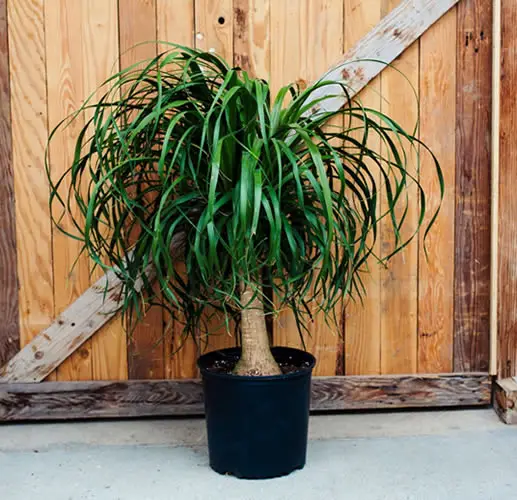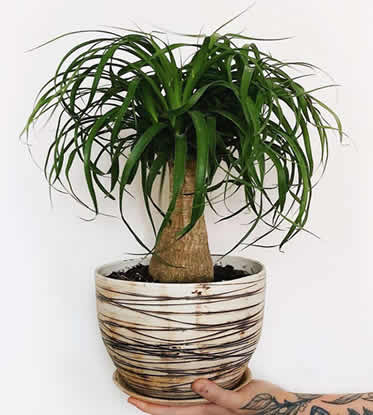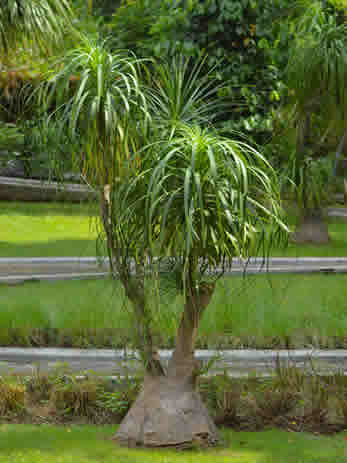The Ponytail Palm (Beaucarnea recurvata) is one of the most charming and low-maintenance houseplants you can grow. With its bulbous trunk and fountain of curly, cascading leaves, it brings personality and structure to any space. Despite its name and appearance, it’s not actually a palm—it’s a succulent in disguise.
Whether you’re tucking it into a sunny corner or placing it on a patio for the summer, the Ponytail Palm will thrive with very little fuss.
Table of Contents
- Ponytail Palm
- Light Needs: Bright, Sunny, and Warm
- Watering: Less Is More
- Humidity and Temperature: Dry and Cozy Is Just Fine
- Fertilizer: Gentle Feeding for Strong Growth
- Soil and Repotting: Keep It Light and Free-Draining
- Pruning and Maintenance: Keep It Clean, Not Cut Back
- Best Spot in the Home: Where Ponytail Palms Shine
- Outdoor Care: A Sun-Lover’s Dream in the Right Climate
- Common Problems and Fixes
- Final Thoughts
Ponytail Palm
Native to the arid regions of southeastern Mexico, Beaucarnea recurvata is part of the Asparagaceae family and is well-adapted to hot, dry conditions.
It stores water in its swollen base—called a caudex—making it exceptionally drought-tolerant.

This plant can grow into a small tree outdoors in warm climates, but indoors it usually stays under 4 feet tall, growing slowly and steadily.
Its fun, ponytail-like leaves and striking base make it a living sculpture that’s as resilient as it is decorative.
Light Needs: Bright, Sunny, and Warm
Ponytail Palms thrive in bright light and full sun.
A south or west-facing window is ideal, but they can tolerate medium light if necessary.
The more sun they receive, the stronger and more compact their growth will be.
Insufficient light may cause slow growth and thinning leaves.
Watering: Less Is More
This plant doesn’t need frequent watering.
Allow the soil to dry out completely between waterings, and when you do water, soak the soil thoroughly.
Overwatering is the most common problem—too much moisture can cause root or trunk rot.
During winter, cut back even more and water only when the soil is bone dry.
Humidity and Temperature: Dry and Cozy Is Just Fine
The Ponytail Palm loves average to warm indoor temperatures between 60°F and 85°F.

It doesn’t require added humidity and is very tolerant of dry indoor air, making it perfect for homes with central heating.
Just keep it away from freezing drafts and cold windows in winter.
Fertilizer: Gentle Feeding for Strong Growth
Feed once every 4 to 6 weeks during the growing season with a balanced liquid houseplant fertilizer.
Look for something with an NPK ratio of 10-10-10 like this one, or 20-20-20 like this one, and dilute it to half strength.
You can also use a cactus or succulent fertilizer, as they’re formulated for low-nutrient needs.
Skip fertilizing in the fall and winter.
Soil and Repotting: Keep It Light and Free-Draining
Use a cactus or succulent potting mix with good drainage, or amend regular soil with sand and perlite.
Ponytail Palms prefer being slightly root-bound, so only repot every 3 to 4 years or when the roots completely fill the pot.
Choose a pot with drainage holes to prevent soggy soil.
Pruning and Maintenance: Keep It Clean, Not Cut Back
Ponytail Palms don’t require pruning to stay in shape. Just trim away any brown or dry leaf tips with clean scissors.
If a leaf dies completely, remove it at the base.
Keep the trunk and leaves free of dust by gently wiping them down every so often.
Consider using your pruned cuttings for propagation following the detailed instructions in the article Ponytail Palm Propagation: How to Multiply This Unique, Drought-Loving Plant.
Best Spot in the Home: Where Ponytail Palms Shine
This plant loves sunrooms, bright living rooms, and south-facing windowsills where it can soak up sunshine and stay dry.

It’s a great choice for warm, sunny corners that other plants might find too dry.
The sculptural trunk and playful leaves also make it a natural centerpiece.
Outdoor Care: A Sun-Lover’s Dream in the Right Climate
In USDA zones 9–11, Ponytail Palms can grow outdoors year-round and even reach small tree size.
In cooler climates, they can spend the summer outside on a patio or balcony.
Choose a spot with full sun and excellent drainage, and allow the soil to dry between waterings.
Bring the plant back indoors before nighttime temperatures dip below 50°F.
Be sure to rinse off the foliage and check for pests before transitioning it back inside.
Common Problems and Fixes
Brown leaf tips usually mean the air is too dry or the plant has been underwatered
Fix it by trimming the tips and checking your watering schedule—dry air won’t hurt it, but dry roots will

Yellowing leaves may be a sign of overwatering
Fix it by letting the soil dry completely and checking that your pot drains well
Soft or mushy base is a sign of root or caudex rot
Fix it by removing the plant from its pot, trimming any rotted roots, and repotting in fresh, dry soil
Stretched, leggy growth usually comes from too little light
Fix it by moving the plant to a sunnier spot with more direct light
Leaf drop is rare, but can happen from sudden temperature changes or prolonged overwatering
Fix it by placing the plant in a consistent, warm location and adjusting watering habits
Final Thoughts
The Ponytail Palm is an ideal companion for plant lovers who appreciate sculptural form and low-maintenance care.
Its quirky shape, drought-tolerance, and forgiving nature make it a great fit for bright indoor spaces and sunny patios alike.
With just a little light and a lot of patience, this plant will stay happy and handsome for years to come.

